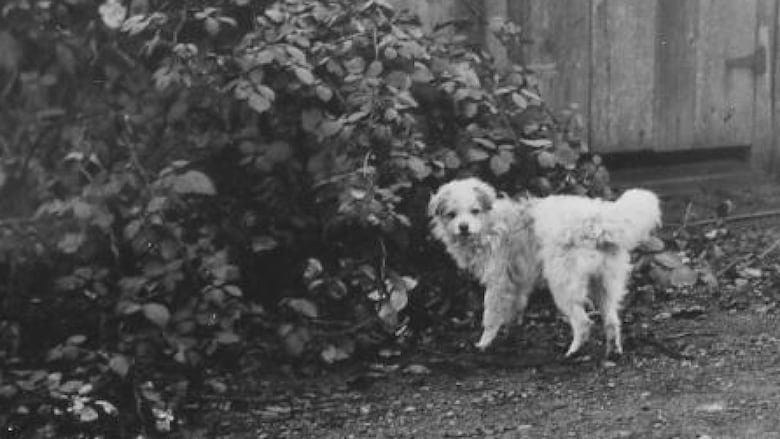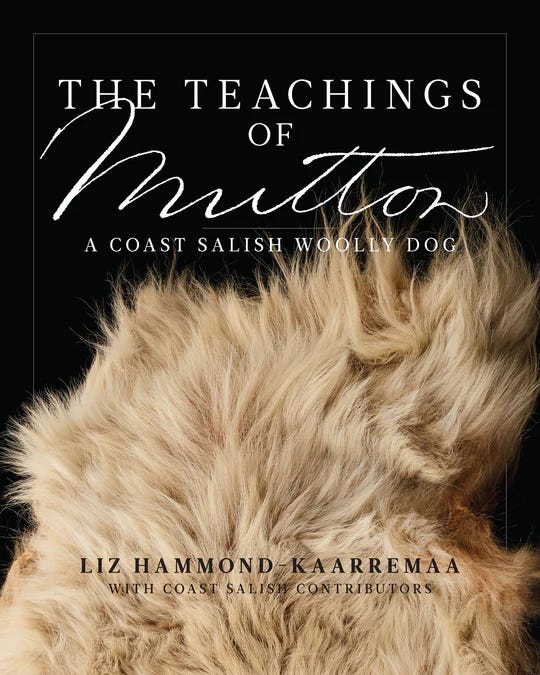The Teachings of Mutton by Liz Hammond-Kaarremaa
Reviewed by Lisa Timpf
The Teachings of Mutton, A Coast Salish Woolly Dog is an apt title. This book written by Liz Hammond-Kaarremaa, with Coast Salish contributors, follows Hammond-Kaarremaa’s efforts to track down information about Coast Salish Woolly Dogs generally and a dog named Mutton in particular. But Hammond-Kaarremaa’s research, and her discussions with Coast Salish Elders, Knowledge Keepers, artists, weavers, and others also illuminates new information about Coast Salish weaving, the adverse effects of colonialism, and the importance of Oral History.
“Woolly Dogs were a special species of dog carefully bred and tended over thousands of years by the Coast Salish people, who used their wool for weaving.”
The way Hammond-Kaarremaa has chosen to frame the story maintains reader interest. Readers are presented with a series of questions Hammond-Kaarremaa encountered in the course of her research, and feel like they are discovering the answers (or conjectures and best guesses) as Hammond-Kaarremaa tracks down data using journals, oral history, paintings, documents, weavings, and perhaps most importantly, studying the pelt of Mutton, a Coast Salish Woolly Dog. The dog’s pelt had been donated to the Smithsonian, and had remained essentially undisturbed for 150 years before it was discovered by an amateur archivist.
Woolly Dogs were a special species of dog carefully bred and tended over thousands of years by the Coast Salish people, who used their wool for weaving. Around the mid-1800s, the dogs died out. A number of factors contributed to the dogs’ demise, such as disease which wiped out huge number of Coast Salish people, including those who looked after the dogs, canine diseases impacting the dogs themselves, and changes to Coast Salish cultures as a result of colonialism.
Hammond-Kaarremaa examines the often-mistaken Eurocentric assumptions made about the Woolly Dogs and their care, finding evidence through DNA, oral history, and examination of historical objects that dispels some of the incorrect information and misconceptions.
Offered in an eight-by-ten-inch format, with quality paper and numerous colour illustrations, The Teachings of Mutton is both visually and intellectually appealing. One hundred figures—paintings, sketches, photographs, copies of written records, and so on—are included, complementing the text and enhancing understanding. Among the illustrations are examples of Coast Salish woven work, photographs of spindles and other spinning and weaving tools used by the Coast Salish people, and landscape paintings by James Madison Alden, an artist hired to paint scenes as the US Boundary Commission surveyed the 49th boundary.
The book also includes the insights, memories, and observations of Coast Salish people, which adds texture and depth to the story of Woolly Dogs and their care, Coast Salish weaving, and the impact of colonialism. The observations of the Coast Salish contributors demonstrate the importance of respecting Oral History, in order to avoid the misinterpretations that can occur when someone looking at a culture from the outside imposes their own biases.

As an example, there had been some speculation that one of the reasons the Coast Salish Woolly Dogs died out was that with the wider availability of Hudson’s Bay blankets and other trade goods, there was no need to engage in the laborious work of harvesting, preparing, and weaving dog wool blankets. Hammond-Kaarremaa doesn’t buy it, pointing to the cultural and spiritual value placed on the traditional blankets, robes, and regalia woven by the Coast Salish people. “A dog wool blanket, whose fibres, spinning and weaving were imbued with cultural importance, could not have been replaced by imported, mass-produced blankets . . . The demise of the Woolly Dog is often explained by a non-Indigenous worldview of economics and not through a cultural lens,” she notes.
Near the end of the book Hammond-Kaarremaa writes, “Mutton’s pelt has acted like a teacher. His teachings have revealed so much, to so many people—not only about dog wool and Woolly Dog aDNA and diet, not only about blankets and weaving and spinning, but about the enduring strength of Oral History.”
The Teachings of Mutton is a thoroughly researched and intriguing story about the Coast Salish Woolly Dogs and their cultural significance, and about Coast Salish weaving techniques. But on another level, it offers another example of the negative impact of colonialism, and demonstrates the value of delving into Oral History and traditional knowledge in truly understanding history and culture.
About the Author
Liz Hammond-Kaarremaa has a MA in educational technology and holds a Master Spinner Certificate from Olds College. She is a researcher of Coast Salish spinning and collaborates with museums and Indigenous communities, sharing her knowledge through research writing, workshops and lectures. Her research and publications focus on Coast Salish textiles, including articles in academic journals (Science, BC Studies) and magazines (Spin-Off, Ply, Selvedge). She lives on Protection Island, near Nanaimo, BC..
Alison Ariss, Andrea Fritz, Chepximiya Siyam Chief Janice George, Danielle Morsette, Eliot White-Hill, Jared Qwustenuxun Williams, Kerrie Charnley, Michael (CHiX-ap-kaid) Pavel, Quwasen Debra Sparrow, sa’ hLa mitSa Susan Pavel, Senaqwila Wyss, Snumithia' Violet Elliott, Tuwuxwul't-hw Tyrone Elliott, Xweliqwiya Rena Point Bolton also contributed to this book.
About the Reviewer
Lisa Timpf lives in Simcoe, Ontario, where she writes poetry, book reviews, short stories, and creative nonfiction. Lisa’s speculative poetry collections Cats and Dogs in Space (2025) and In Days to Come (2022) are available from Hiraeth Publishing. Lisa is a member of SF Canada and the Science Fiction and Fantasy Poetry Association. You can find out more about Lisa’s writing projects at http://lisatimpf.blogspot.com/. Lisa is also on Bluesky, @lisatimpf.bsky.social.
Book Details
Publisher: Harbour Publishing
Publication Date: 20/05/2025
Paperback / softback Length: 8 in x 10 in - 264 pp
ISBN-10: 199852602X
ISBN-13: 978-1998526024




